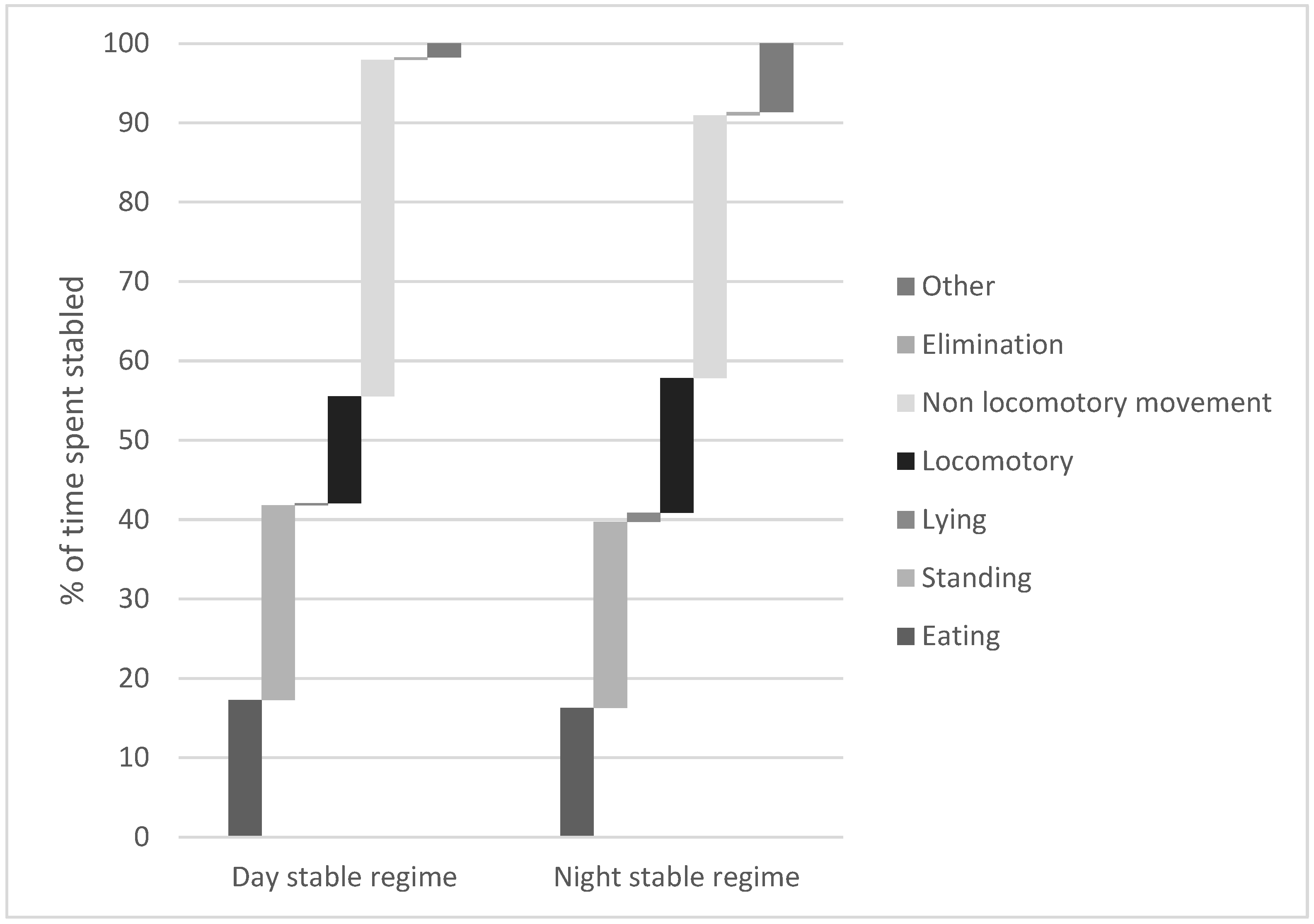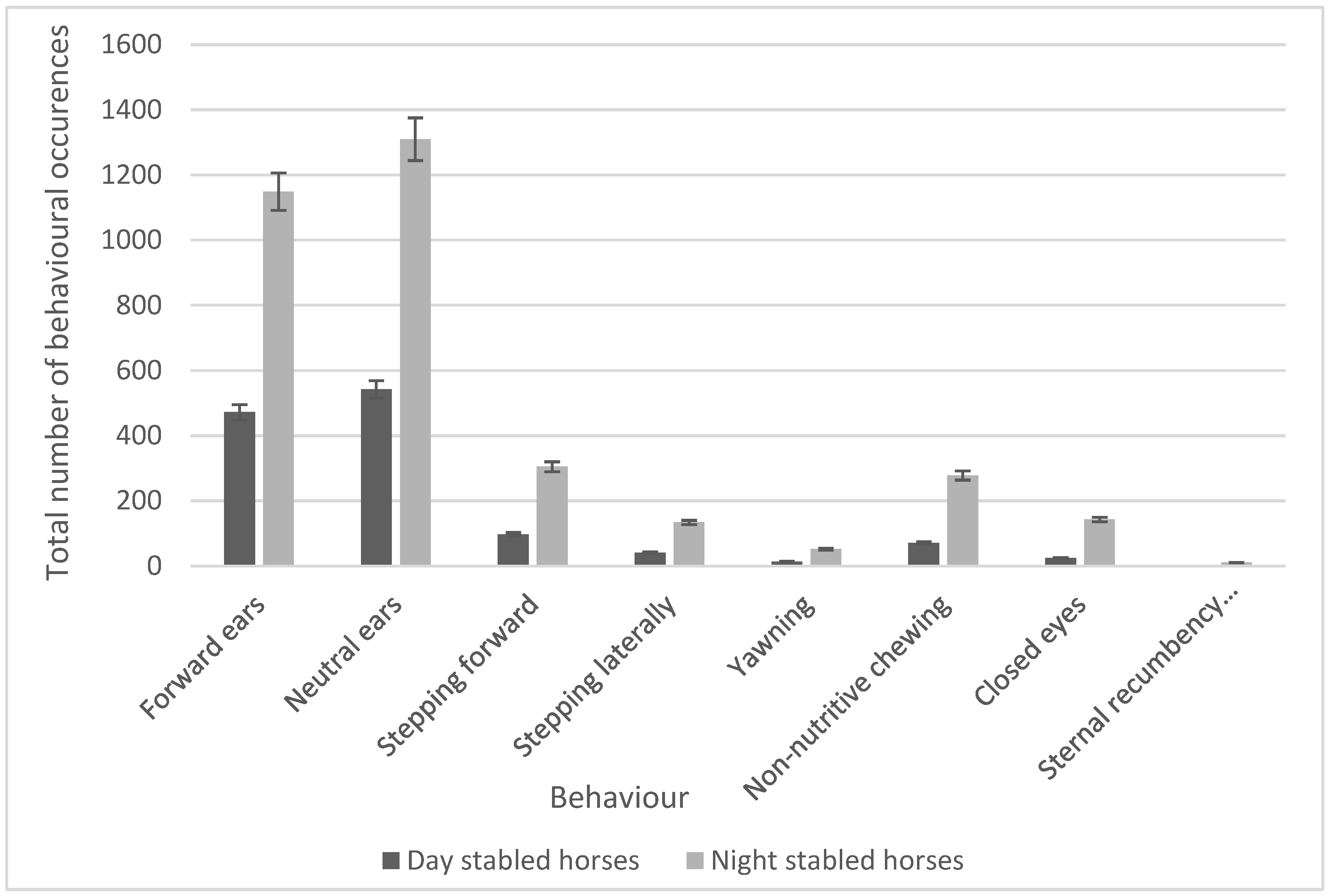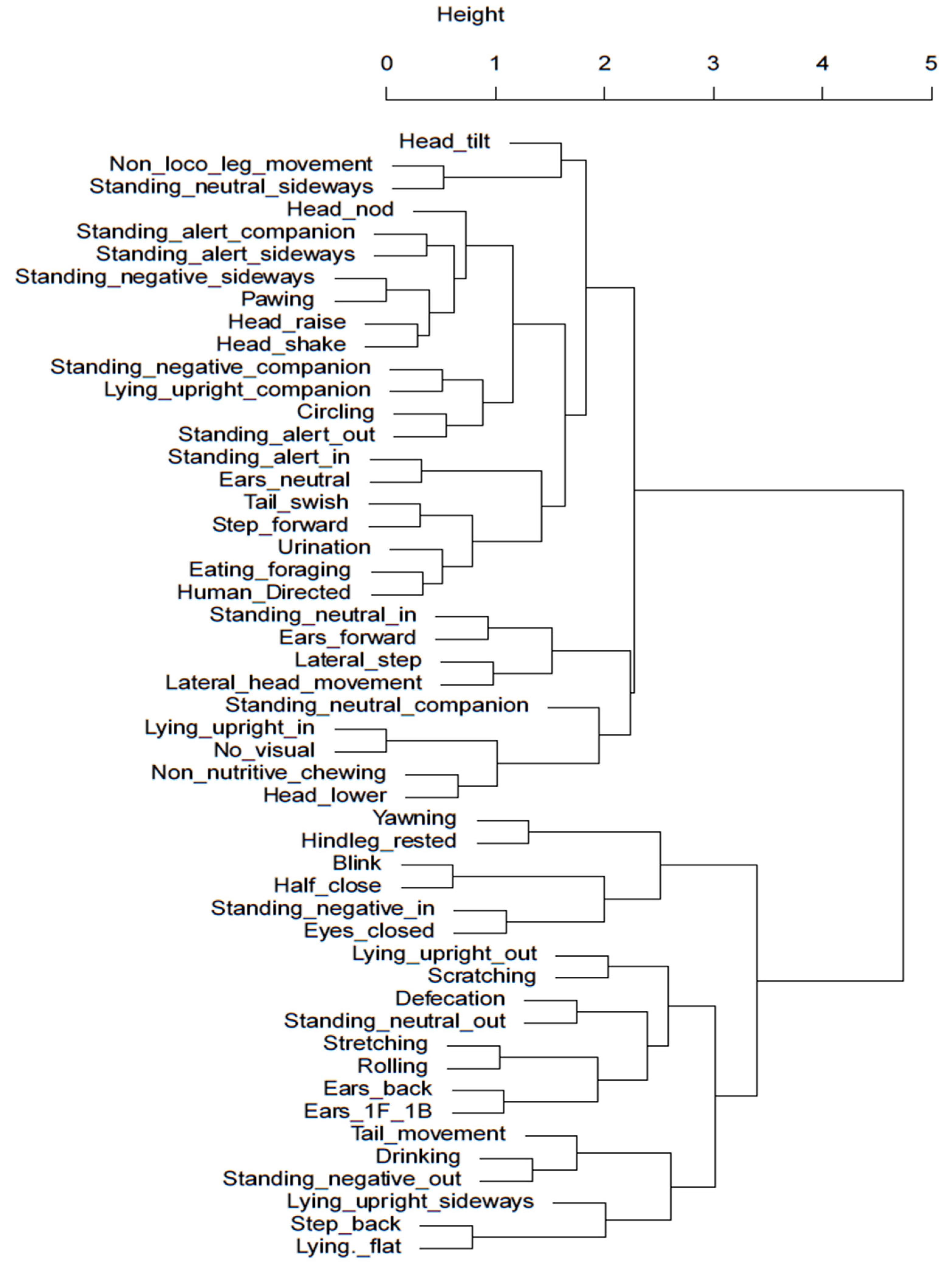The Effect of Stabling Routines on Potential Behavioural Indicators of Affective State in Horses and Their Use in Assessing Quality of Life
Abstract
Simple Summary
Abstract
1. Introduction
2. Materials and Methods
2.1. Subjects
2.2. Horse Housing and Management
2.3. Materials
2.4. Procedure
2.5. Data Extraction and Collation
2.6. Data Analysis
2.7. Statistical Analysis
2.8. Ethical Approval
3. Results
3.1. Time Budgets
3.2. Significant Behaviours
4. Discussion
5. Conclusions
Author Contributions
Funding
Institutional Review Board Statement
Informed Consent Statement
Data Availability Statement
Acknowledgments
Conflicts of Interest
References
- Waran, N.; Randle, H. What we can measure, we can manage: The importance of using robust welfare indicators in Equitation Science. Appl. Anim. Behav. Sci. 2017, 190, 74–81. [Google Scholar] [CrossRef]
- Boissy, A.; Arnould, C.; Chaillou, E.; Desire, L.; Duvaux-Ponter, C.; Greiveldinger, L.; Veissier, I. Emotion and cognition: A new approach to animal welfare. Anim. Welf. 2007, 16, 37–43. [Google Scholar] [CrossRef]
- Dalla Costa, E.; Minero, M.; Lebelt, D.; Stucke, D.; Canali, E.; Leach, M.C. Development of the Horse Grimace Scale (HGS) as a pain assessment tool in horses undergoing routine castration. PLoS ONE 2014, 9, e92281. [Google Scholar] [CrossRef]
- Fraser, D. Toward a global perspective on farm animal welfare. Appl. Anim. Behav. Sci. 2008, 113, 330–339. [Google Scholar] [CrossRef]
- Mellor, D.J. Updating animal welfare thinking: Moving beyond the “Five Freedoms” towards “A Life Worth Living”. Animals 2016, 24, 21. [Google Scholar] [CrossRef] [PubMed]
- Mellor, D.J.; Beausoleil, N.J.; Littlewood, K.E.; McLean, A.N.; McGreevy, P.D.; Jones, B.; Wilkins, C. The 2020 Five Domains model: Including human-animal interactions in assessments of animal welfare. Animals 2020, 10, 1870. [Google Scholar] [CrossRef] [PubMed]
- Hall, C.; Randle, H.; Pearson, G.; Preshaw, L.; Waran, N. Assessing equine emotional state. Appl. Anim. Behav. Sci. 2018, 205, 183–193. [Google Scholar] [CrossRef]
- Horseman, S.V.; Buller, H.; Mullan, S.; Whay, H.R. Current welfare problems facing horses in Great Britain as identified by equine stakeholders. PLoS ONE 2016, 11, e0160269. [Google Scholar] [CrossRef]
- Hockenhull, J.; Furtado, T. Escaping the gilded cage: Could COVID-19 lead to improved equine welfare? A review of the literature. Appl. Anim. Behav. Sci. 2021, 237, 105303. [Google Scholar] [CrossRef]
- Mills, D.; Clarke, A. Housing, management and welfare. In The Welfare of Horses; Waran, N., Ed.; Springer: Dordrecht, The Netherlands, 2007; Volume 1, pp. 77–97. [Google Scholar]
- Hemsworth, L.M.; Jongman, E.; Coleman, G.J. Recreational horse welfare: The relationships between recreational horse owner attributes and recreational horse welfare. Appl. Anim. Behav. Sci. 2015, 165, 1–16. [Google Scholar] [CrossRef]
- Holcombe, S.J.; Jackson, C.; Gerber, V.; Jefcoat, A.; Berney, C.; Eberhardt, S.; Robinson, N.E. Stabling is associated with airway inflammation in young Arabian horses. Eq. Vet. J. 2001, 33, 244–249. [Google Scholar] [CrossRef]
- Couëtil, L.L.; Cardwell, J.M.; Gerber, V.; Lavoie, J.P.; Léguillette, R.; Richard, E.A. Inflammatory Airway Disease of horses—Revised consensus statement. J. Vet. Sc. 2016, 30, 503–515. [Google Scholar] [CrossRef]
- Hansen, S.; Klintoe, K.; Austevoll, M.; Baptiste, K.E.; Fjeldborg, J. Equine airway inflammation in loose-housing management compared with pasture and conventional stabling. Vet. Rec. 2019, 184, 590–595. [Google Scholar] [CrossRef] [PubMed]
- Hepburn, R. Gastric ulceration in horses. Practice 2011, 33, 116–124. [Google Scholar] [CrossRef]
- Majecka, K.; Klawe, A. Influence of paddock size on social relationships in domestic horses. J. Appl. Anim. Welf. Sci. 2018, 21, 8–16. [Google Scholar] [CrossRef]
- Yarnell, K.; Hall, C.; Royle, C.; Walker, S.L. Domesticated horses differ in their behavioural and physiological responses to isolated and group housing. Phys. Behav. 2015, 143, 51–57. [Google Scholar] [CrossRef]
- Kiley-Worthington, M. The Behaviour of Horses: In Relation to Management and Training; J. A. Allen: London, UK, 1997. [Google Scholar]
- Christensen, J.W.; Ladewig, J.; Søndergaard, E.; Malmkvist, J. Effects of individual versus group stabling on social behaviour in domestic stallions. Appl. Anim. Behav. Sci. 2002, 75, 233–248. [Google Scholar] [CrossRef]
- Visser, E.K.; Ellis, A.D.; Van Reenen, C.G. The effect of two different housing conditions on the welfare of young horses stabled for the first time. Appl. Anim. Behav. Sci. 2008, 114, 521–533. [Google Scholar] [CrossRef]
- Heleski, C.R.; Shelle, A.C.; Nielsen, B.D.; Zanella, A.J. Influence of housing on weanling horse behaviour and subsequent welfare. Appl. Anim. Behav. Sci. 2002, 78, 291–302. [Google Scholar] [CrossRef]
- Cooper, J.; McGreevy, P.D. Stereotypic behaviour in the stabled horses: Causes, effects and prevention without compromising horse welfare. In The Welfare of Horses; Waran, N., Ed.; Springer: Dordrecht, The Netherlands; Volume 1, pp. 68–76.
- Cooper, J.J.; Mason, G.J. The identification of abnormal behaviour and behavioural problems in stabled horses and their relationship to horse welfare: A comparative review. Eq. Vet. J. 1998, 30, 5–9. [Google Scholar] [CrossRef] [PubMed]
- Luescher, U.A.; McKeown, D.B.; Dean, H. A cross-sectional study on compulsive behaviour (stable vices) in horses. Eq. Vet. J. 1998, 30, 14–18. [Google Scholar] [CrossRef] [PubMed]
- Hartman, N.; Greening, L.M. A preliminary study investigating the influence of auditory stimulation on the occurrence of nocturnal equine sleep-related behaviour in stabled horses. J. Eq. Vet. Sci. 2019, 82, 102782. [Google Scholar] [CrossRef]
- Kelemen, Z.; Grimm, H.; Vogl, C.; Long, M.; Cavalleri, J.M.; Auer, U.; Fenner, F. Equine activity time budgets: The effect of housing and management conditions on geriatric horses and horses with chronic orthopedic disease. Animals 2021, 11, 1867. [Google Scholar] [CrossRef]
- Randle, H.; Henshall, C.; Hall, C.; Pearson, G.; Preshaw, L.; Waran, N. Indicators on the inside: Physiology and equine quality of life. In Proceedings of the International Society for Equitation Science Conference, Guelph, ON, Canada, 19–22 August 2019. [Google Scholar]
- Noble, G.K. Horse husbandry—Nutrition, management and welfare. Animals 2022, 13, 169. [Google Scholar] [CrossRef]
- National Research Council. Nutritional Requirements of Horses. Available online: https://nrc88.nas.edu/nrh/ (accessed on 3 September 2018).
- Kiley-Worthington, M. Ecological, ethological and ethically sound environments for animals: Toward symbiosis. J. Agric. Ethics 1989, 2, 323–347. [Google Scholar] [CrossRef]
- R Core Team. R: A language and environment for statistical computing. In R Foundation for Statistical Computing; R Core Team: Vienna, Austria, 2020. [Google Scholar]
- Mellor, D.J.; Beausoleil, N.J. Extending the “Five Domains” model for animal welfare assessment to incorporate positive welfare states. Anim. Welf. 2015, 24, 241. [Google Scholar] [CrossRef]
- Boissy, A.; Manteuffel, G.; Jensen, M.B.; Moe, R.O.; Spruijt, B.; Keeling, L.J.; Aubert, A. Assessment of positive emotions in animals to improve their welfare. Phys. Behav. 2007, 92, 375–397. [Google Scholar] [CrossRef] [PubMed]
- Greening, L.; McBride, S. A review of equine sleep: Implications for equine welfare. Front. Vet. Sci. 2022, 9, 916737. [Google Scholar] [CrossRef] [PubMed]
- Werhahn, H.; Hessel, E.F.; Bachhausen, I.; Van den Weghe, H.F. Effects of different bedding materials on the behaviour of horses housed in single stalls. J. Eq. Vet. Sci. 2010, 30, 425–431. [Google Scholar] [CrossRef]
- Raabmagle, P.; Ladewig, J. Lying behaviour in horses in relation to box size. J. Eq. Vet. Sci. 2006, 26, 11–17. [Google Scholar] [CrossRef]
- Mazzola, S.M.; Colombani, C.; Pizzamiglio, G.; Cannas, S.; Palestrini, C.; Dalla Costa, E.M.; Gazzonis, A.L.; Bionda, A.; Crepaldi, P. Do you think I am living well? A four-season hair cortisol analysis on leisure horses in different housing and management conditions. Animals 2021, 11, 2141. [Google Scholar] [CrossRef]
- Clegg, H.A.; Buckley, P.; Friend, M.A.; McGreevy, P.D. The ethological and physiological characteristics of cribbing and weaving horses. Appl. Anim. Behav. Sci. 2008, 109, 68–76. [Google Scholar] [CrossRef]
- Schuurman, S.O.; Kersten, W.; Weijs, W.A. The equine hind limb is actively stabilized during standing. J. Vet. Anat. 2003, 202, 355–362. [Google Scholar] [CrossRef] [PubMed]
- Fureix, C.; Jego, P.; Henry, S.; Lansade, L.; Hausberger, M. Towards an ethological animal model of depression? A study on horses. PLoS ONE 2012, 7, e39280. [Google Scholar] [CrossRef] [PubMed]
- Hall, C.; Kay, R.; Yarnell, K. Assessing ridden horse behaviour: Professional judgement and physiological measures. J. Vet. Behav. 2014, 9, 22–29. [Google Scholar] [CrossRef]
- Reefmann, N.; Kaszàs, F.B.; Wechsler, B.; Gygax, L. Ear and tail postures as indicators of emotional valence in sheep. Appl. Anim. Behav. Sci. 2009, 118, 199–207. [Google Scholar] [CrossRef]
- Dyson, S.; Berger, J.M.; Ellis, A.D.; Mullard, J. Can the presence of musculoskeletal pain be determined from the facial expressions of ridden horses (FEReq)? J. Vet. Behav. 2017, 19, 78–89. [Google Scholar] [CrossRef]
- Hall, C.; Huws, N.; White, C.; Taylor, E.; Owen, H.; McGreevy, P.D. Assessment of ridden horse behaviour. J. Vet. Behav. Clin. Appl. Res. 2013, 9, 62–73. [Google Scholar] [CrossRef]
- Chamove, A.S.; Crawley-Hatrick, O.J.; Stafford, K.J. Horse reactions to human attitudes and behaviour. Anthrozoös 2003, 15, 323–331. [Google Scholar] [CrossRef]
- Lie, M.; Newberry, R.C. Horse communication: What does non-nutritive chewing mean? In Proceedings of the International Society for Equitation Science Conference, Rome, Italy, 23 September 2018.
- Seeley, R.R.; Stephens, T.D.; Tate, P. Anatomy and Physiology, 5th ed.; McGraw Hill: St. Louis. MO, USA, 2000. [Google Scholar]
- Fureix, C.; Forecka-Bruzda, A.; Gautier, E.; Hausberger, M. Co-occurrence of yawning and stereotypic behaviour in horses (Equus caballus). Int. Sch. Res. Not. 2011, 2011, 271209. [Google Scholar] [CrossRef]
- Giganti, F.; Zilli, I.; Aboudan, S.; Salzarulo, P. Sleep, sleepiness and yawning. Mystery Yawning Physiol. Dis. 2010, 28, 42–46. [Google Scholar]
- Rossman, Z.T.; Hart, B.L.; Greco, B.J.; Young, D.; Padfield, C.; Weidner, L.; Gates, J.; Hart, L.A. When yawning occurs in elephants. Front. Vet. Sci. 2017, 4, 22. [Google Scholar] [CrossRef] [PubMed]
- Palagi, E.; Guillen-Salazar, F.; Llamazares-Martin, C. Spontaneous yawning and its potential functions in South American sea lions (Otaria flavescens). Sci. Rep. 2019, 9, 17226. [Google Scholar] [CrossRef] [PubMed]
- Gallup, A.C. The causes and consequences of yawning in animal groups. Anim. Behav. 2022, 187, 209–219. [Google Scholar] [CrossRef]
- Gorecka-Bruzda, A.; Fureix, C.; Ouvard, A.; Bourjade, M.; Hausberger, M. Investigating determinants of yawning in the domestic (Equus caballus) and Przewalski (Equus ferus przewalskii) horses. Sci. Nat. 2016, 103, 72. [Google Scholar] [CrossRef]
- Hothersall, B.; Casey, R. Undesired behaviour in horses: A review of their development, prevention, management and association with equine welfare. Eq. Vet. Ed. 2012, 24, 479–485. [Google Scholar] [CrossRef]
- Sarrafchi, A.; Blokhuis, H.J. Equine stereotypic behaviours: Causation, occurrence, and prevention. J. Vet. Behav. 2013, 8, 386–394. [Google Scholar] [CrossRef]
- Fureix, C.; Pagès, M.; Bon, R.; Lassalle, J.M.; Kuntz, P.; Gonzalez, G. A preliminary study of the effects of handling type on horses’ emotional reactivity and the human-horse relationship. Behav. Proc. 2009, 82, 202–210. [Google Scholar] [CrossRef]




| Horse | Age (Years) | Breed | Sex | BCS | Workload | Stabling Routine |
|---|---|---|---|---|---|---|
| Horse 1 | 8 | WB | G | 3.75 | Moderate | Night |
| Horse 2 | 14 | WBX | G | 3 | Heavy | Night |
| Horse 3 | 6 | WBX | G | 3.5 | Light | Night |
| Horse 4 | 16 | ASH | G | 3 | Moderate | Day |
| Horse 5 | 9 | QHX | G | 4 | Moderate | Day |
| Horse 6 | 12 | WBX | G | 3.5 | Moderate | Day |
| Horse 7 | 9 | PREX | G | 3.5 | Heavy | Night |
| Horse 8 | 21 | ASHX | G | 2.5 | Light | Night |
| Horse 9 | 8 | TB | G | 4 | Light | Day |
| Horse 10 | 15 | QHX | G | 3 | Moderate | Day |
| Behaviour Category | Behaviour | Definition |
|---|---|---|
| Eat | Eating/foraging | Seeking, nutritive chewing, and ingestion of substrate provided by owner |
| Drinking | Consumption of water provided by owner | |
| Stand | Standing positive (in/out/sideways/companion) | Horse standing with head and neck position higher than the wither (facing away from the stable door/facing towards the stable door, facing parallel to the stable door/facing a conspecific) |
| Standing neutral (in/out/sideways/companion) | Horse standing with head and neck position approximately level with the withers (facing away from the stable door/facing towards the stable door, facing parallel to the stable door/facing a conspecific) | |
| Standing negative (in/out/sideways/companion) | Horse standing with head and neck position lower than the neck and withers (facing away from the stable door/facing towards the stable door, facing parallel to the stable door/facing a conspecific) | |
| Hind leg rested | Hind leg transferred into a non-weight-bearing position with slight flexion and incomplete contact of the hoof to stable floor | |
| Lie | Lateral recumbency | The horse lying on one lateral side of its entire body, usually including head and neck. The head can briefly be held up by lateral flexion of the neck. Limbs can be held in different positions |
| Sternal recumbency (in/out/sideways/companion) | The horse lying on the lateral side of the front and hindlimb closest to the ground and the ventrolateral part of the torso. The legs are more or less flexed and the head can be held upright or resting on the ground or its front legs | |
| Locomotory | Step(s) forward | Step(s) transferring horse’s body in a forward direction |
| Step(s) backward | Step(s) reversing horse’s body in a backwards direction | |
| Lateral step(s) | Step(s) transferring horse in a sideways direction that is neither forwards nor backwards | |
| Circling (partial/complete) | A full or partial movement of the horse’s body around the perimeter of the stable | |
| Non-locomotory | Tail movement | Gentle lateral or vertical movement of the tail |
| Tail swishing | Forceful lateral or vertical movement of the tail | |
| Non-locomotory leg movement | Movement of the legs that does not transfer the body forwards, backwards, or laterally | |
| Head raise | Raising of the head within the parameters of the horse’s stance (positive, neutral, or negative) | |
| Head lower | Lowering of the head within the parameters of the horse’s stance (positive, neutral, or negative) | |
| Head nod | A brief movement of the head in successive upward and downward motion | |
| Head tilt | A brief movement of the head on the lateral plane | |
| Lateral head movement | Movement of the horse’s head to either side | |
| Head shake | Rapid, rhythmic rotation of the head and neck along the long axis while standing with feet planted | |
| Scratching | Nibbling, biting, licking, or rubbing a part of the body | |
| Stretching | Rigid extension of the limbs and arching of the neck and back | |
| Elimination | Urination | Forelegs slightly extended forward and hind legs extended backward and slightly spread, expelling of urine through the urethra. The penis is typically partially or fully relaxed from the prepuce |
| Defecation | With tail raised, expelling of faecal matter through the anus | |
| Other | Non-nutritive chewing | Chewing motion displayed by the horse without the consumption of food |
| Yawning | A deep, long inhalation with mouth widely open and jaws either directly opposed or moving from side to side | |
| Human directed | Horse facing and/or approaching human on the outside of the stable | |
| Rolling | Dropping from standing to sternal recumbency, and then rotating one or more times from sternal to dorsal recumbency, tucking the legs against the body | |
| Tactile nose rubbing | Repeated movement of the horse’s nostrils against the bars of the stable wall on the lateral plane | |
| Conspecific aggression | Aggressive behaviour aimed at conspecific in neighbouring stall | |
| Pawing | A foreleg is lifted off the ground slightly, extended quickly in the forward direction, and followed by a backward, toe-dragging movement as if digging. This movement is typically repeated several times in succession | |
| Voluntary approach | Horse willingly approaches human on entry into stall | |
| Unspecified | Ears back | Ears pressed caudally against the head and neck |
| Ears forward | Ears held stiffly upright and forwards | |
| Ears neutral | Ears relaxed and facing laterally | |
| Ears 1F1B | Ears alternate forwards and backwards, remaining in this position for varied lengths of time | |
| Blink (eye) | Complete closure and reopening of the horse’s eyelid | |
| Half-close (eye) | Half closure and reopening of the horse’s eyelid | |
| Eyes closed | Complete and sustained closure of the horse’s eyelid | |
| No visual contact | Horse cannot be adequately seen on any camera |
Disclaimer/Publisher’s Note: The statements, opinions and data contained in all publications are solely those of the individual author(s) and contributor(s) and not of MDPI and/or the editor(s). MDPI and/or the editor(s) disclaim responsibility for any injury to people or property resulting from any ideas, methods, instructions or products referred to in the content. |
© 2023 by the authors. Licensee MDPI, Basel, Switzerland. This article is an open access article distributed under the terms and conditions of the Creative Commons Attribution (CC BY) license (https://creativecommons.org/licenses/by/4.0/).
Share and Cite
Bradshaw-Wiley, E.; Randle, H. The Effect of Stabling Routines on Potential Behavioural Indicators of Affective State in Horses and Their Use in Assessing Quality of Life. Animals 2023, 13, 1065. https://doi.org/10.3390/ani13061065
Bradshaw-Wiley E, Randle H. The Effect of Stabling Routines on Potential Behavioural Indicators of Affective State in Horses and Their Use in Assessing Quality of Life. Animals. 2023; 13(6):1065. https://doi.org/10.3390/ani13061065
Chicago/Turabian StyleBradshaw-Wiley, Ella, and Hayley Randle. 2023. "The Effect of Stabling Routines on Potential Behavioural Indicators of Affective State in Horses and Their Use in Assessing Quality of Life" Animals 13, no. 6: 1065. https://doi.org/10.3390/ani13061065
APA StyleBradshaw-Wiley, E., & Randle, H. (2023). The Effect of Stabling Routines on Potential Behavioural Indicators of Affective State in Horses and Their Use in Assessing Quality of Life. Animals, 13(6), 1065. https://doi.org/10.3390/ani13061065





